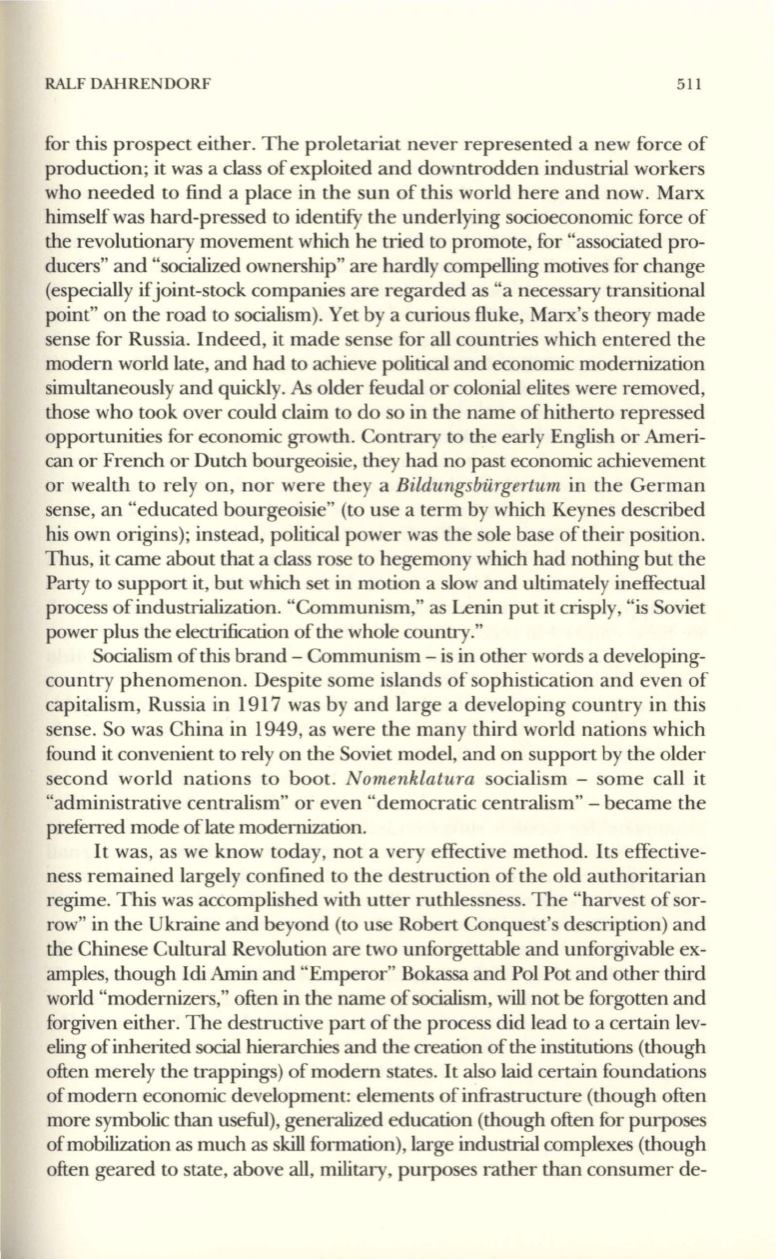
RALF DAHRENDORF
511
for this prospect either. The proletariat never represented a new force of
production; it was a class of exploited and downtrodden industrial workers
who needed to find a place in the sun of this world here and now. Marx
himself was hard-pressed to identify the underlying socioeconomic force of
the revolutionary movement which he tried to promote, for "associated pro–
ducers" and "socialized ownership" are hardly compelling motives for change
(especially ifjoint-stock companies are regarded as "a necessary transitional
point" on the road to socialism). Yet by a curious fluke, Marx's theory made
sense for Russia. Indeed, it made sense for all countries which entered the
modern world late, and had to achieve political and economic modernization
simultaneously and quickly. As older feudal or colonial elites were removed,
those who took over could claim to do so in the name of hitherto repressed
opportunities for economic growth. Contrary to the early English or Ameri–
can or French or Dutch bourgeoisie, they had no past economic achievement
or wealth to rely on, nor were they a
Bildungsburgertum
in the German
sense, an "educated bourgeoisie" (to use a term by which Keynes described
his own origins); instead, political power was the sole base of their position.
Thus, it came about that a class rose to hegemony which had nothing but the
Party to support it, but which set in motion a slow and ultimately ineffectual
process of industrialization. "Communism," as Lenin put it crisply, "is Soviet
power plus the electrification of the whole country."
Socialism of this brand - Communism - is in other words a developing–
country phenomenon. Despite some islands of sophistication and even of
capitalism, Russia in 1917 was by and large a developing country in this
sense. So was China in 1949, as were the many third world nations which
found it convenient to rely on the Soviet model, and on support by the older
second world nations to boot.
Nomenklatura
socialism - some call it
"administrative centralism" or even "democratic centralism" - became the
preferred mode oflate modernization.
It
was, as we know today, not a very effective method. Its effective–
ness remained largely confined to the destruction of the old authoritarian
regime. This was accomplished with utter ruthlessness. The "harvest of sor–
row" in the Ukraine and beyond (to use Robert Conquest's description) and
the Chinese Cultural Revolution are two unforgettable and unforgivable ex–
amples, though Idi
AmID
and "Emperor" Bokassa and Pol Pot and other third
world "modernizers," often in the name of socialism, will not
be
forgotten and
forgiven either. The destructive part of the process did lead to a certain lev–
eling of inherited social hierarchies and the creation of the institutions (though
often merely the trappings) of modern states.
It
also laid certain foundations
ofmodern economic development: elements of infrastructure (though often
more symbolic than useful), generalized education (though often for purposes
ofmobilization as much as skill formation), large industrial complexes (though
often geared to state, above
all,
military, purposes rather than consumer de-


